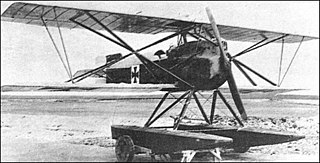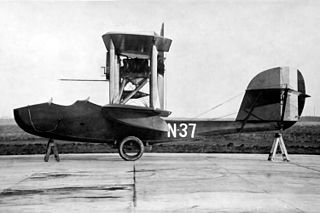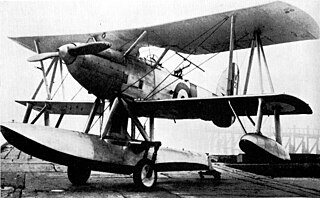Related Research Articles

The Sopwith Tabloid and Sopwith Schneider (floatplane) were British biplanes, originally designed as sports aircraft and later adapted for military use. They were among the first successful types to be built by the Sopwith Aviation Company. The "Tabloid", so named because of its small size, caused a sensation when it made its first public appearance.
The Fairey Hamble Baby was a British single-seat naval patrol floatplane designed and built by Fairey Aviation for the Royal Naval Air Service

The Hawker Dantorp H.B. III was a Danish single-engined biplane bomber of the 1930s. The aircraft was a development of the British Hawker Horsley designed for the Danish Navy, but differed in being powered by a radial engine and having a third crew member. Two examples were built in Britain as a precursor to license production in Denmark. Financial constraints meant this was not realised and the Hawker-built examples were the only aircraft produced. They served until the German invasion of Denmark in 1940.

The Hansa-Brandenburg KDW was a German single-engine, single-seat, fighter floatplane of World War I. The KDW – Kampf Doppeldecker, Wasser – was adapted from the Hansa-Brandenburg D.I landplane to provide coastal defence over the North Sea.

The Hansa-Brandenburg W.19 was a German fighter-reconnaissance aircraft of World War I. It was a single-engined two-seat biplane floatplane, and was a larger development of the successful W.12. It served with the Kaiserliche Marine during 1918.

The Supermarine Sea King was a British single-seat amphibious biplane fighter designed by Supermarine in 1919. Developed from the Supermarine Baby and the Supermarine Sea Lion I, the Sea King was a single seater biplane powered by a pusher 160 horsepower (120 kW) Beardmore engine. It first flew in early 1920 and was exhibited by Supermarine at the 1920 Olympia Show in London. The company released drawings of the aircraft's design prior to the show; what it exhibited was probably a modified Supermarine Baby.

The Supermarine Baby was a First World War fighter aircraft that was the earliest example of a single-seat flying boat fighter to be built in the United Kingdom. It was designed by Supermarine to meet a 1917 Navy Board specification which stipulated the aircraft have a speed of 95 knots, a ceiling of 20,000 feet (6,100 m), and be capable of being launched from ships at sea. When it first flew in February 1918 it was the smallest and fastest flying boat then in existence.
The Sopwith Admiralty Type 807 was a 1910s British biplane seaplane designed and built for the Admiralty by the Sopwith Aviation Company.
The Gloster II was a British racing floatplane of the 1920s. A single-engined biplane, two were built to compete in the 1924 Schneider Trophy air race. However the crash of the first prototype during testing meant that it could not be made ready for the race, which was postponed. The second aircraft was also lost in a crash.

The Gloster Goring was a single-engined two-seat biplane designed to meet 1926 Air Ministry specifications for a day/torpedo bomber. It was not put into production and the one aircraft built served later as an engine testbed.
The Westland Wagtail was a prototype British fighter aircraft of the First World War. A single-engined tractor biplane, the Wagtail was a failure owing to the unreliability of its engine, only five being built.
The Sopwith Snapper was a prototype British fighter aircraft of the First World War. A single-engined biplane designed by the Sopwith Aviation Company to replace the Sopwith Snipe fighter, it first flew after the end of the war, but did not enter service owing to the failure of its engine, only three aircraft being built.

The Norman Thompson N.1B was a prototype British flying boat fighter aircraft of the First World War. A two-seat single-engined pusher biplane, a single example was built in 1917, but no production followed.
The Sopwith Gunbus was a British fighter aircraft of the First World War. It was a single-engined pusher biplane based on a floatplane built by Sopwith before the war for Greece. Small numbers were built and used by the British Royal Naval Air Service, mainly as a trainer.

The Short Gurnard was a single-engined two-seat biplane naval fighter, built in the United Kingdom to an Air Ministry specification in 1929. It failed to win production orders and only two flew.
The Port Victoria P.V.9 was a British single-seat biplane floatplane fighter of the First World War. Although claimed to be the best aircraft of its type yet to be tested, only a single prototype was built.

The Vought XSO2U was an American observation floatplane developed by Vought-Sikorsky for the United States Navy during the late 1930s. Intended to replace the Curtiss SOC Seagull in service as a scout aboard cruisers, it proved superior to the Curtiss SO3C in evaluation, but failed to win a production contract due to Vought's lack of manufacturing capacity.
The Sopwith Special torpedo seaplane Type C was the first British aircraft designed to drop torpedoes. A single-engine biplane floatplane, it flew in July 1914 but proved unable to lift the design load and was soon abandoned.
The Port Victoria P.V.5 was a British single-engined floatplane fighter aircraft of the First World War. A single example was built and flown at the Royal Naval Air Service's Port Victoria Marine Experimental Aircraft Depot on the Isle of Grain in 1917. Despite demonstrating good manoeuvrability and handling, no production followed, with the Royal Naval Air Service instead using landplanes for the fighter role.
The Hansa-Brandenburg W.25 was a German floatplane fighter of the World War I era, designed and built by Hansa-Brandenburg.
References
- Bruce, J.M. British Aeroplanes 1914–18. London:Putnam, 1957.
- James, Derek N. Westland Aircraft since 1915. London:Putnam, 1991. ISBN 0-85177-847-X.
- Mason, Francis K. The British Fighter since 1912. Annapolis, USA:Naval Institute Press, 1992. ISBN 1-55750-082-7.